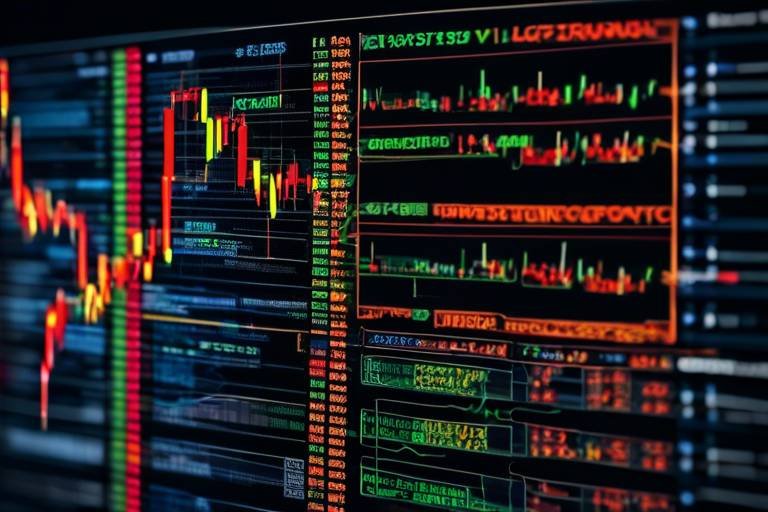Understanding the 80/20 Rule in Trading
The 80/20 rule, often referred to as the Pareto Principle, is a fascinating concept that can revolutionize the way traders approach their strategies. At its core, this principle suggests that a mere 20% of your efforts can yield a staggering 80% of your results. Imagine spending your time on only the most impactful trades while watching your profits soar! In the world of trading, this means that a small fraction of your trades is likely responsible for the majority of your gains. So, how can you harness this powerful principle to optimize your trading performance?
Understanding the 80/20 rule is not just about recognizing that some trades are more profitable than others; it's about strategically focusing your energy and resources where they will make the most significant impact. Think of it as a spotlight illuminating the path to success in a dark room filled with opportunities. By identifying the key trades that contribute most to your profits, you can streamline your decision-making process, enhance your risk management strategies, and ultimately become a more effective trader.
In the upcoming sections, we will dive deeper into how you can apply the 80/20 rule to your trading strategies. We will explore methods for identifying those high-impact trades, utilizing performance metrics to refine your approach, and balancing risk versus reward effectively. Additionally, we'll discuss how optimizing your time management can lead to better trading outcomes. By the end of this article, you'll have a clearer understanding of how to leverage the 80/20 rule to your advantage, transforming your trading journey into a more focused and rewarding experience.
The essence of the 80/20 rule lies in its simplicity and effectiveness. It posits that 80% of effects come from just 20% of the causes. In trading, this principle helps traders pinpoint which trades yield the most significant results. For instance, if you analyze your past trades, you may find that a handful of successful trades account for the bulk of your profits. By focusing on these key trades, you can make more informed decisions and allocate your resources more efficiently.
To truly enhance your trading strategies, it’s crucial to identify the 20% of trades that are responsible for 80% of your profits. This requires a keen eye for detail and a willingness to analyze your trading history. By leveraging data analytics and performance metrics, you can uncover patterns and trends that reveal your most impactful trades. This not only allows you to concentrate your efforts on what works but also helps in refining your overall trading strategy.
Recognizing which trades contribute most to your overall success is crucial. To do this, you can employ various methods for analyzing past trades. Look for trades that consistently deliver substantial returns and evaluate the factors contributing to their success. This could involve examining market conditions, your decision-making process, and the timing of your trades. By understanding what makes these trades successful, you can replicate that success in future transactions.
Performance metrics provide invaluable insights into your trading effectiveness. Key metrics to track include:
- Win Rate: The percentage of trades that are profitable.
- Average Gain vs. Average Loss: Comparing your average profits to your average losses.
- Risk-Reward Ratio: The potential reward of a trade compared to its risk.
By monitoring these metrics, you can identify your most impactful trades and refine your strategies accordingly.
Understanding the balance between risk and reward is essential for any trader. The 80/20 rule can be applied here by evaluating potential trades based on their risk-reward profiles. Focus on trades that offer a favorable risk-reward ratio, ensuring that the potential upside significantly outweighs the downside. This approach not only enhances your profitability but also helps in managing risk more effectively.
Time management is another critical aspect of successful trading. By applying the 80/20 rule, you can prioritize your time on the most profitable activities and analyses. This means dedicating more time to researching and executing those high-impact trades while minimizing time spent on less productive activities. By doing so, you can maximize your trading efficiency and improve your overall performance.
While the 80/20 rule is a powerful tool, misapplication can lead to significant pitfalls. It’s crucial to be aware of these common mistakes and how to avoid them for better outcomes.
One of the most significant errors traders make is focusing solely on the top 20%. While these trades are essential, neglecting the remaining 80% can be detrimental. This portion may contain valuable insights and opportunities that could enhance your trading strategy. By acknowledging the contributions of all trades, you can develop a more comprehensive approach to trading.
Data misinterpretation can lead to poor trading decisions. To ensure you correctly analyze data based on the 80/20 rule, consider employing analytical tools and resources that can help clarify your findings. This way, you can make informed choices that contribute to your trading success.
1. What is the 80/20 rule in trading?
The 80/20 rule, or Pareto Principle, suggests that 80% of results come from 20% of efforts. In trading, this means a small number of trades often lead to the majority of profits.
2. How can I identify my high-impact trades?
Analyze your trading history to find trades that consistently yield significant returns. Look for patterns and factors that contribute to their success.
3. What performance metrics should I track?
Key metrics include win rate, average gain vs. average loss, and risk-reward ratio. These will help you assess your trading effectiveness.
4. How can I apply the 80/20 rule to risk management?
Focus on trades with a favorable risk-reward ratio, ensuring potential profits significantly outweigh potential losses.

The Basics of the 80/20 Rule
The 80/20 rule, also known as the Pareto Principle, is a fascinating concept that suggests that a small percentage of causes often leads to a large percentage of effects. In simpler terms, it means that roughly 80% of your results come from only 20% of your efforts. This principle can be applied across various fields, but in the context of trading, it holds significant weight. Understanding this rule can help traders focus their energy on the most impactful trades, ultimately leading to better decision-making and improved performance.
When it comes to trading, recognizing the key trades that contribute to your overall success is crucial. Imagine you're a gardener; instead of watering every single plant equally, you’d want to identify the 20% of plants that yield the most fruit or flowers. By concentrating your resources on these high-impact areas, you maximize your returns with less effort. In trading, this translates to identifying which trades consistently deliver substantial profits and focusing your strategy around them.
Moreover, the 80/20 rule encourages traders to analyze their past trades. By examining which trades brought in the most profit, traders can begin to understand their own patterns and behaviors. This analysis can be as simple as keeping a trading journal or using software tools that track performance metrics. For instance, a trader might discover that a few specific strategies or market conditions consistently lead to success, while others yield minimal results. This insight is invaluable, as it allows traders to refine their strategies and allocate their time and resources more effectively.
To illustrate the power of the 80/20 rule in trading, let’s consider a hypothetical scenario. Suppose a trader executes 100 trades within a year. Upon review, they find that only 20 of those trades generated 80% of their profits. By recognizing this pattern, the trader can shift their focus to those high-performing trades, learning from their successes and perhaps even eliminating or minimizing the strategies that led to losses. This approach not only enhances profitability but also reduces the emotional stress often associated with trading.
In summary, the 80/20 rule is not just a theoretical concept; it’s a practical tool that can transform the way traders approach their strategies. By focusing on the critical 20% of trades that yield the majority of profits, traders can optimize their performance and make more informed decisions. So, the next time you find yourself overwhelmed with trading options, remember to apply this principle. It might just be the key to unlocking your trading potential!

Applying the 80/20 Rule to Trading Strategies
The 80/20 rule, or the Pareto Principle, is not just a theoretical concept; it’s a powerful tool that traders can leverage to enhance their trading strategies. Imagine walking into a store and realizing that 80% of the sales come from just 20% of the products. In trading, this principle translates to the idea that a small number of trades can generate the majority of your profits. So, how do you identify and focus on these golden trades? Let’s dive into the nitty-gritty of applying the 80/20 rule to your trading strategies.
First off, it’s essential to understand that not all trades are created equal. Some trades will yield substantial returns while others may barely break even. This is where the 80/20 rule comes into play. By analyzing your past trades, you can pinpoint which ones have been the most profitable. But how do you do this effectively? One method is to maintain a detailed trading journal. In this journal, you can track various details about each trade, including the entry and exit points, the assets involved, and the market conditions at the time.
Once you have a record of your trades, the next step is to evaluate their performance. You can create a simple performance metrics table to visualize which trades have been the most successful. Here’s an example of what that might look like:
| Trade | Profit/Loss | Duration | Market Conditions |
|---|---|---|---|
| Trade A | $500 | 2 days | Bullish |
| Trade B | $100 | 5 days | Bearish |
| Trade C | $700 | 1 day | Bullish |
From this table, you can easily see that Trade C was a high-impact trade that contributed significantly to your overall profits. The next step is to analyze what made this trade successful. Was it the timing? The asset? The market conditions? Understanding these factors can help you replicate your success in future trades.
Another essential aspect of applying the 80/20 rule is evaluating risk versus reward. Not every trade that falls into your top 20% will be a guaranteed win. It’s crucial to assess the potential risks involved. This means calculating the risk-reward ratio for each trade. A good rule of thumb is to aim for a ratio of at least 1:2, meaning you stand to gain $2 for every $1 you risk. By focusing on trades that offer a favorable risk-reward ratio, you can increase the likelihood of maintaining profitability over time.
Now, let’s talk about optimizing your time management. Time is often one of the most overlooked resources in trading. By applying the 80/20 rule, you can prioritize your time on activities that drive the most significant results. For instance, if you find that analyzing specific market trends leads to your best trades, dedicate more time to that analysis instead of getting bogged down in less impactful activities like excessive research on every single asset.
In conclusion, applying the 80/20 rule to your trading strategies can be a game-changer. By identifying the trades that contribute the most to your profits, evaluating risk versus reward, and optimizing your time management, you can significantly enhance your trading performance. Remember, the goal is not just to trade more but to trade smarter. So, take a step back, analyze your trades, and focus on what truly matters in your trading journey.
- What is the 80/20 rule? The 80/20 rule, or Pareto Principle, suggests that 80% of outcomes come from 20% of causes.
- How can I identify my top 20% trades? By maintaining a trading journal and analyzing your performance metrics.
- Why is risk versus reward important? It helps you evaluate whether a trade is worth the potential risk involved.
- How can I optimize my time as a trader? Focus on high-impact activities that yield the best results, rather than spreading yourself too thin.

Identifying High-Impact Trades
When it comes to trading, the ability to identify high-impact trades can be a game-changer. Imagine navigating a vast ocean; you wouldn't waste time sailing in circles when you could be heading straight for the treasure. Similarly, recognizing which trades yield the highest returns allows traders to focus their efforts on the most lucrative opportunities. So, how do you pinpoint these golden trades? It all starts with analyzing past performance and understanding the market dynamics.
One effective method to identify high-impact trades is through a thorough examination of your trading history. By reviewing your previous trades, you can uncover patterns that reveal which trades consistently deliver substantial returns. Look for trades where the market conditions were favorable and where you executed your strategy flawlessly. This analysis will not only highlight your winning trades but also shed light on the conditions that led to those successes.
Additionally, utilizing performance metrics can significantly aid in identifying high-impact trades. Metrics such as the win rate, average profit per trade, and risk-reward ratio provide valuable insights into your trading effectiveness. For instance, a high win rate with a low average profit might indicate that while you win frequently, the trades aren’t yielding enough profit to justify the effort. On the other hand, a lower win rate but a high average profit per trade could signal that you are making fewer but more impactful trades. Keeping track of these metrics can help you refine your strategy and focus on the trades that matter most.
Another critical aspect is understanding the market context. High-impact trades often occur during significant market events or trends. For example, economic reports, earnings announcements, or geopolitical events can create opportunities for substantial price movements. By staying informed about these events and their potential impact on the markets, you can position yourself to take advantage of high-impact trades as they arise.
Furthermore, consider categorizing your trades based on their impact. You might create a simple table to track your trades, noting down the following:
| Trade | Entry Point | Exit Point | Profit/Loss | Market Conditions |
|---|---|---|---|---|
| Trade 1 | 1.1000 | 1.1500 | +$500 | Positive Economic Data |
| Trade 2 | 1.2000 | 1.1800 | -$200 | Market Correction |
| Trade 3 | 1.3000 | 1.3500 | +$700 | Geopolitical Tension |
This table format allows you to visualize which trades had the most significant impact on your overall performance. By regularly updating this table, you can track your progress and adjust your strategies accordingly. Remember, the goal is to focus on the trades that not only bring in profits but also align with your trading style and risk tolerance.
In summary, identifying high-impact trades is about being proactive and analytical. By reviewing past trades, utilizing performance metrics, staying informed about market events, and categorizing your trades, you can sharpen your focus on the opportunities that truly matter. In trading, as in life, it’s often the small, focused efforts that lead to the greatest rewards. So, gear up, analyze, and let the 80/20 rule guide you to those high-impact trades!
- What is the 80/20 rule in trading? The 80/20 rule, or Pareto Principle, suggests that 80% of outcomes come from 20% of causes, meaning that a small number of trades often lead to the majority of profits.
- How can I identify my high-impact trades? By analyzing your trading history, utilizing performance metrics, and staying informed about market conditions, you can identify which trades have the most significant impact on your success.
- Why is it important not to overlook the 80%? While focusing on the top 20% is crucial, neglecting the remaining 80% can lead to missed opportunities and a lack of comprehensive understanding of your trading performance.

Utilizing Performance Metrics
When it comes to trading, understanding and utilizing performance metrics is like having a roadmap for your journey. Just as a driver checks their speed and fuel level, traders must keep an eye on key metrics to navigate the volatile markets effectively. These metrics not only provide insights into your trading effectiveness but also help you identify which trades are truly driving your success. Imagine you’re a chef; the performance metrics are your secret ingredients that can elevate your dishes from good to unforgettable.
One of the most crucial performance metrics traders should focus on is the win rate. This percentage tells you how often your trades are profitable. A high win rate might feel like a warm blanket on a cold day, but it’s essential to balance it with the risk-reward ratio. This ratio helps you understand if the potential profits justify the risks you’re taking. If you’re consistently winning small amounts but losing big on a few trades, you might want to rethink your strategy.
Another vital metric is the average trade duration. Are you holding onto trades for too long, hoping for a miracle, or are you quick to cut losses? Knowing your average trade duration can help you refine your approach. If you find that most of your profitable trades are short-lived, it might be wise to adopt a more aggressive exit strategy. Conversely, if your successful trades tend to be longer-term, then patience could be your best friend.
To make the most of these metrics, consider creating a trading journal. This journal can serve as a powerful tool to track your trades, analyze performance, and reflect on your decision-making process. Think of it as your personal trading diary where you can jot down your thoughts, strategies, and the outcomes of your trades. You can include metrics like:
- Date of trade
- Entry and exit points
- Win/loss status
- Profit or loss amount
- Notes on market conditions
By regularly reviewing this journal, you can identify patterns in your trading behavior, spot areas for improvement, and ultimately leverage the 80/20 rule more effectively. For instance, if you notice that a small number of trades consistently yield high profits, you can focus your efforts on similar trades in the future. This targeted approach not only enhances your strategy but also saves time and energy, allowing you to concentrate on what truly matters.
In summary, utilizing performance metrics is not just about crunching numbers; it’s about gaining insights that can transform your trading approach. By understanding your win rate, risk-reward ratio, and average trade duration, and by maintaining a detailed trading journal, you can make informed decisions that align with the 80/20 rule. So, are you ready to take your trading to the next level?
1. What are performance metrics in trading?
Performance metrics in trading are quantifiable measures that help traders evaluate their trading performance, including win rates, risk-reward ratios, and average trade durations.
2. Why are performance metrics important?
Performance metrics are crucial because they provide insights into a trader's effectiveness, helping to identify strengths and weaknesses in trading strategies.
3. How can I track my performance metrics?
You can track your performance metrics by maintaining a trading journal where you record details of each trade, including entry and exit points, profits or losses, and any insights gained.
4. What should I do if my win rate is low?
If your win rate is low, it may be time to reassess your trading strategy. Consider analyzing past trades to identify patterns that lead to losses and adjust your approach accordingly.
5. Can performance metrics help me manage risk?
Yes, performance metrics can help you evaluate your risk-reward ratio and make more informed decisions about which trades to pursue, ultimately leading to better risk management.

Evaluating Risk vs. Reward
In the world of trading, understanding the delicate balance between risk and reward is not just important; it's absolutely crucial. Imagine you're standing at the edge of a diving board, contemplating whether to leap into the deep end. The height represents your potential risk, while the refreshing water below symbolizes the reward you might reap. Just like that leap, trading requires careful consideration of what you stand to gain against what you might lose.
When applying the 80/20 rule to evaluate potential trades, it’s essential to ask yourself: "What is the potential reward, and what is the risk involved?" This question is not merely a formality; it’s the cornerstone of sound trading strategy. By focusing on the 20% of trades that promise to yield 80% of your profits, you can hone in on those opportunities that offer the best risk-to-reward ratios.
To further illustrate this, let’s consider a simple table that outlines a few hypothetical trades:
| Trade | Potential Reward | Potential Risk | Risk-to-Reward Ratio |
|---|---|---|---|
| Trade A | $400 | $100 | 4:1 |
| Trade B | $300 | $150 | 2:1 |
| Trade C | $600 | $300 | 2:1 |
From this table, you can see that Trade A presents a much more favorable risk-to-reward ratio compared to Trades B and C. In essence, for every dollar you risk in Trade A, you stand to gain four. This is the kind of trade that should be at the forefront of your strategy when applying the 80/20 rule. Remember, it's not just about making trades; it’s about making the right trades that align with your risk tolerance and financial goals.
Moreover, the 80/20 rule can also help you identify which trades to avoid. If a potential trade has a risk-to-reward ratio of less than 1:1, it might be wise to steer clear. After all, why would you want to put your hard-earned capital on the line for a trade that doesn't offer a significant upside?
In summary, evaluating risk versus reward is an art that every trader must master. By applying the 80/20 rule to your trading strategy, you can better focus your efforts on the trades that not only promise the highest returns but also align with your risk threshold. Always remember that in trading, as in life, the best opportunities often come with calculated risks.
- What is the 80/20 rule in trading? The 80/20 rule, also known as the Pareto Principle, suggests that 80% of results come from 20% of efforts. In trading, this means that a small number of trades may account for the majority of your profits.
- How can I identify high-impact trades? Analyzing your past trades and their outcomes can help you pinpoint which trades consistently yield significant returns. Look for patterns in your trading history.
- Why is risk management important? Risk management is crucial because it helps protect your capital and ensures that you can continue trading in the long run. Balancing risk and reward is key to sustainable trading success.

Optimizing Time Management in Trading
Time management in trading is often the unsung hero of successful strategies. Imagine you're a chef in a bustling kitchen; if you spend too much time on one dish, the others might burn. Similarly, in trading, if you don't allocate your time wisely, you may miss out on crucial opportunities. The 80/20 rule can be your secret ingredient to optimizing your trading time. By focusing on the 20% of activities that yield 80% of your results, you can streamline your trading process and enhance your overall performance.
One effective way to implement this principle is by identifying your most productive trading hours. Just like a morning person might excel in tasks early in the day, understanding when you are most alert and focused can significantly impact your trading success. Start by tracking your trading performance over a few weeks. Note the times when you make the most profitable trades and the conditions surrounding them. Once you have this data, you can structure your trading sessions around these peak times.
In addition to identifying peak trading hours, consider categorizing your trading activities. For instance, you might divide your tasks into three main categories: analysis, execution, and review. By focusing on the 20% of tasks that lead to 80% of your profits, you can prioritize your efforts. Here’s a simple breakdown:
| Task Category | Focus Areas | Potential Impact |
|---|---|---|
| Analysis | Market trends, news analysis, technical indicators | Identifying high-impact trades |
| Execution | Trade placement, order types, timing | Maximizing profit potential |
| Review | Performance metrics, strategy adjustments | Continuous improvement |
Moreover, consider setting specific time limits for each of these activities. Just as a chef has a prep time for each dish, you should allocate a fixed amount of time for analysis, execution, and review. This not only keeps you focused but also prevents you from falling into the trap of over-analysis, which can lead to missed opportunities. By setting a timer, you can maintain a steady pace and ensure that you're not spending too much time on any one task.
Lastly, don’t forget to incorporate breaks into your trading routine. It may sound counterintuitive, but taking short breaks can actually enhance your focus and efficiency. Think of it as recharging your batteries. A quick walk or a few minutes of stretching can clear your mind and prepare you for the next trading session. Remember, even the best traders need to step back occasionally to maintain their edge.
In summary, optimizing time management in trading is about identifying your peak performance hours, categorizing your tasks, setting time limits, and incorporating breaks. With the 80/20 rule as your guiding principle, you can ensure that your time is spent on activities that truly matter, allowing you to maximize your trading success.
- What is the 80/20 rule in trading?
The 80/20 rule, or Pareto Principle, suggests that 80% of results come from 20% of efforts. In trading, this means a small number of trades may yield the majority of your profits. - How can I identify my most profitable trades?
Analyze your past trading data, looking for patterns in your most successful trades. Focus on the conditions and strategies that led to those profits. - Why is time management important in trading?
Effective time management allows traders to focus on high-impact activities, reducing stress and increasing the likelihood of making profitable trades. - How can I improve my trading efficiency?
By applying the 80/20 rule, categorizing tasks, setting time limits, and taking breaks, you can enhance your trading efficiency and overall performance.

Common Pitfalls in Applying the 80/20 Rule
While the 80/20 rule is a powerful tool for traders, its application can sometimes lead to mistakes that hinder performance. One of the most significant pitfalls is the tendency to focus solely on the top 20% of trades, which can create a narrow viewpoint. This approach may yield short-term gains, but it can also blind traders to opportunities within the remaining 80%. It’s crucial to recognize that even the less impactful trades can provide valuable insights or contribute to a trader's overall strategy.
Another common mistake is misinterpreting data. In the fast-paced world of trading, data analysis is essential, but it’s easy to misread trends or overemphasize certain metrics. For instance, a trader might focus on a single successful trade and assume similar results will follow, neglecting the broader context. This tendency can lead to poor decision-making, as it overlooks the importance of a comprehensive analysis of all trades.
To avoid these pitfalls, traders should regularly evaluate their performance across all trades, not just the high performers. Here are some strategies to help mitigate these risks:
- Conduct Regular Reviews: Set aside time to analyze both successful and unsuccessful trades. This will help you understand what works and what doesn’t.
- Maintain a Balanced Perspective: Don’t ignore the 80%. Some trades may not yield immediate results but can offer valuable lessons.
- Use a Variety of Metrics: Instead of relying on a single performance metric, consider multiple indicators to get a clearer picture of your trading effectiveness.
In summary, while the 80/20 rule can significantly enhance trading strategies, it’s essential to apply it wisely. By avoiding the temptation to overlook the broader picture and ensuring accurate data interpretation, traders can maximize their potential for success.
Q1: What is the 80/20 rule in trading?
A1: The 80/20 rule, or Pareto Principle, suggests that 80% of results come from 20% of efforts. In trading, this means that a small percentage of trades often contribute to the majority of profits.
Q2: How can I identify the 20% of trades that generate 80% of my profits?
A2: Analyze your past trading performance by reviewing your trades and their outcomes. Look for patterns in the trades that consistently yield high returns and focus on replicating those strategies.
Q3: What are some common mistakes when applying the 80/20 rule?
A3: Common mistakes include focusing only on the top 20% of trades, which can lead to overlooking valuable insights from the remaining 80%, and misinterpreting data, which can result in poor trading decisions.
Q4: How often should I review my trades?
A4: Regular reviews are essential. Consider conducting a detailed analysis at least once a month to assess your trading performance and adjust your strategies accordingly.

Overlooking the 80%
When traders become overly focused on the top 20% of their trades, they often make a critical mistake: they overlook the remaining 80%. This oversight can be detrimental to their overall performance. Why? Because while the top 20% may yield the most significant profits, the other 80% can still contribute valuable insights and opportunities that shouldn't be ignored. Think of it like a garden; if you only water the flowers and neglect the weeds, you might end up with a patchy landscape that doesn't thrive.
It's essential to recognize that the 80% of trades may include a mix of losers and winners. By analyzing these trades, traders can uncover patterns and trends that can inform future decisions. For instance, perhaps a trader consistently loses money on a certain type of trade or during specific market conditions. By understanding these factors, they can adjust their strategies accordingly, avoiding similar pitfalls in the future.
Moreover, the 80% can provide context for the successful trades. For example, if a trader has a winning streak, they might assume they have it all figured out. However, if they take a closer look at the trades that made up the other 80%, they might find that their success was merely a result of luck or favorable market conditions. Recognizing this can prevent overconfidence, which is often a trader's worst enemy.
In addition, the 80% can serve as a reservoir of learning opportunities. Each trade, whether successful or not, carries lessons that can refine a trader's approach. For instance, by reviewing losing trades, traders can identify mistakes in their analysis or execution. Did they enter too late? Did they fail to set a stop-loss? These reflections are invaluable for growth and improvement.
To illustrate the importance of not overlooking the 80%, consider the following table that summarizes key insights from analyzing both the top 20% and the bottom 80% of trades:
| Trade Group | Characteristics | Insights Gained |
|---|---|---|
| Top 20% | High profitability, strong execution | Strategies that work, market conditions favorable |
| Bottom 80% | Mixed results, potential losses | Common mistakes, areas for improvement, market conditions to avoid |
In conclusion, while it’s tempting to chase after the high-reward trades, neglecting the 80% can lead to missed opportunities for growth and understanding. By balancing focus and ensuring that the entirety of their trading history is analyzed, traders can develop a more robust strategy that not only capitalizes on the best trades but also learns from the rest. Remember, the goal is not just to win but to continuously improve and adapt in the ever-changing landscape of trading.
- What is the 80/20 rule in trading? The 80/20 rule, or Pareto Principle, suggests that 80% of results come from 20% of efforts. In trading, this means that a small percentage of trades can lead to the majority of profits.
- How can I identify the top 20% of my trades? Analyzing performance metrics, such as profit margins and win/loss ratios, can help you pinpoint which trades consistently yield the best results.
- Is it harmful to focus only on the top 20% of trades? Yes, neglecting the remaining 80% can lead to missed learning opportunities and might create a false sense of security regarding trading strategies.
- What should I do with the other 80% of my trades? Review and analyze them to identify patterns, mistakes, and areas for improvement, which can enhance your overall trading strategy.

Misinterpreting Data
When it comes to trading, data is your best friend, but it can also be your worst enemy if you misinterpret it. Imagine trying to navigate through a dense forest without a map; that's what trading without correctly analyzing data feels like. The 80/20 rule emphasizes focusing on the vital few trades that yield the most significant results, but if your data interpretation is flawed, you could easily miss out on these opportunities.
One common pitfall traders face is relying too heavily on superficial metrics. For example, a trader might look at the total number of trades executed and assume that a high volume correlates with success. However, this can be misleading. It's not about quantity; it's about quality. A few high-impact trades can make all the difference. So, how do you ensure you're interpreting your data correctly?
First, it's essential to dive deeper into your performance metrics. Here are some key aspects to consider:
- Win Rate vs. Profit Factor: A high win rate might seem appealing, but if your losses are significantly larger than your wins, you’re not truly profitable.
- Average Return per Trade: Look beyond just the number of trades and focus on how much you earn on average from each successful trade.
- Consistency: Analyze how often your top trades occur. If they are sporadic, relying solely on them could be risky.
Next, understanding the context of the data is crucial. For instance, if you notice a particular strategy has performed well during a specific market condition, it doesn't mean it will continue to do so in different circumstances. Always consider external factors, such as market volatility and economic indicators, which could impact your trading outcomes.
Moreover, misinterpretation can stem from cognitive biases. Traders often fall prey to confirmation bias, where they only seek data that supports their existing beliefs while ignoring contradictory evidence. This can lead to poor decision-making and missed opportunities. It's vital to maintain an objective perspective when analyzing your trading data.
Lastly, employing data visualization tools can significantly enhance your understanding. Charts and graphs can help illuminate trends and patterns that raw data might obscure. For example, a simple line chart showing your monthly profits can reveal whether your trading strategy is improving or stagnating over time.
In summary, while the 80/20 rule can guide you toward focusing on impactful trades, misinterpreting your data can lead to disastrous outcomes. By digging deeper into your performance metrics, understanding the context, avoiding cognitive biases, and utilizing visualization tools, you can make informed trading decisions that align with your goals.
- What is the 80/20 rule in trading? The 80/20 rule, or Pareto Principle, suggests that 80% of results come from 20% of efforts. In trading, this means that a small number of trades can significantly impact your overall profits.
- How can I identify my top 20% trades? Analyzing past performance metrics such as win rate, average return per trade, and consistency can help you identify which trades contribute most to your success.
- What are common mistakes in data interpretation? Common mistakes include focusing solely on superficial metrics, ignoring context, and falling prey to cognitive biases like confirmation bias.
- How can I improve my data analysis skills? Use data visualization tools, regularly review your trading performance, and seek feedback from experienced traders to enhance your analysis skills.
Frequently Asked Questions
- What is the 80/20 rule in trading?
The 80/20 rule, also known as the Pareto Principle, suggests that 80% of outcomes come from just 20% of causes. In trading, this means that a small number of trades often generate the majority of profits, helping traders focus their efforts on the most impactful actions.
- How can I identify the 20% of trades that yield the most profit?
To pinpoint these key trades, analyze your past trading performance. Look for patterns in trades that consistently deliver high returns. Utilizing performance metrics, such as win rate and average profit per trade, can also help you identify which trades are worth your time and attention.
- What are some common pitfalls when applying the 80/20 rule?
One major pitfall is focusing too much on the top 20% of trades while neglecting the remaining 80%. This can lead to missed opportunities and an incomplete understanding of your trading strategy. Additionally, misinterpreting data can result in poor decision-making, so it's crucial to ensure accurate analysis.
- How can I effectively manage risk using the 80/20 rule?
By applying the 80/20 rule to assess potential trades, you can evaluate the risk versus reward more efficiently. Focus on trades that not only have a high probability of success but also offer favorable risk-reward ratios. This approach helps you make informed decisions that align with your trading goals.
- Can the 80/20 rule help with time management in trading?
Absolutely! By prioritizing the 20% of activities that lead to 80% of your results, you can optimize your trading schedule. This means spending more time on high-impact analyses and strategies, which can significantly enhance your overall trading performance.



















